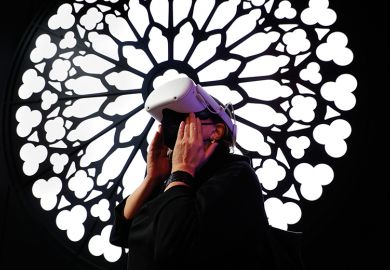Post-pandemic, some of universities’ teaching practices may never return. And that’s a good thing. In parallel, artificial intelligence (AI) is becoming so capable it could start changing how we learn. Covid, perversely, may herald a renaissance for online learning.
Most digital learning today is terrible, resembling “bad television”, as frequent collaborator professor Alex Pentland of MIT puts it. According to a 2019 study, only 3 per cent of students who start an online class finish it. All too often, an “online class” consists of sticking a tripod in the back of a lecture hall, recording a three-hour lecture and posting it online. This is a recipe almost guaranteed to produce failure.
THE Campus resource: How to use online tools to offer more personalised teaching
In a classroom, students have a variety of cognitive prompts that help them focus. At that, the “sage on a stage” model is demonstrably worse at helping them learn than other approaches, such as working in teams or groups to solve problems. Sage on a stage is undeniably good business, though: if universities can pay one professor and have 500 students packed into a lecture hall, they have good efficiency and revenue-to-cost per student.
In recent years, the elusive economic promise of online learning has emerged, where we can have thousands of paying students but only one professor salary to cover. Many universities have decided to optimise revenue at the expense of student experience, creating a growing antipathy to the medium among students.
Online lacks the mental cues required for focus. Noise from our environment, lack of three dimensionality and other atmospherics create a cacophony of distraction. The rapidity with which the pandemic emerged forced many academic institutions to simply deliver classes, unreconstructed, on Zoom.
The “Zoominar” combines all the deficiencies of sage on a stage with all the deficiencies of electronic distraction. It’s not just bad television, it’s bad community-access television or, even worse, bad Youtube − giving rise to the plaintive meme: “Why am I paying $54,000 a year to stream Harvard?” Indeed.
When we need to move from bad television to good learning outcomes, AI, in conjunction with cognitive science, can get us there faster. We can even contemplate the question: what if online could be better than in-class?
One university chancellor shared with me that in the past year, her non-white and female students had much higher group participation rates and better grades. The distancing of the digital medium created space for diversity to enter the discourse.
On campus, I feel good if I get 10 high-quality guest speakers during a 12-week class. I am constrained by travel, intersecting diaries and available time. Online, my innovation classes routinely have 30 to 50 guest speakers providing diverse and robust points of view around complex topics. But we must go further; we need to completely reinvent the form.
THE Campus resource: Top tips for selecting and implementing new technologies
The biggest failure of online is that it is lonely − students sit on their own, with their laptops, watching videos. In contrast, the best learning, on campus, is in teams. On campus, I can walk between tables of students working in breakout groups, quickly hearing and interjecting to help discussions move along. Online, with 10,000 students, this is an impossibility.
Or is it?
We have discovered that we can break down the elements of the instructor-facilitated experience into component parts and turn them into process and technology. I’ve been experimenting with this in collaboration with my business partner, Beth Porter, at Esme Learning.
We ask: what if I could create a digital avatar of myself or, for starters, my ability to facilitate a discussion? What if I could be in 2,000 breakout group discussions simultaneously, nudging my students along a more productive or more collaborative path? What if every single second of students’ online learning experience was designed, optimised, to produce a better result for them?
We have built AI systems that foster patterns of ideal collaboration, in real time, helping guide both video and chat discussions along more productive pathways. With advanced analytics and sophisticated simulations integrated into a next-generation learning platform, we can deliver new heights of engagement and learner performance.
Students in our online classes are showing completion rates of 98 to 100 per cent, not 3 per cent. In one pilot, students were 50 per cent more likely to launch a new venture than if they had engaged in a traditional in-person accelerator.
So we have a tantalising glimpse of what might be. Learning online can generate direct career benefits for the learner and direct economic impact for companies and governments. Realising this promise requires new ways of thinking about learning and a willingness to try new technology, but the payoff is tangible, immediate and urgently needed.
David Shrier is professor of practice, AI and innovation with Imperial College Business School, and author of Augmenting Your Career: How to Win at Work in the Age of AI . The views expressed in this article are his own and are not necessarily reflective of the views of any organisation with which he is affiliated.
Register to continue
Why register?
- Registration is free and only takes a moment
- Once registered, you can read 3 articles a month
- Sign up for our newsletter
Subscribe
Or subscribe for unlimited access to:
- Unlimited access to news, views, insights & reviews
- Digital editions
- Digital access to THE’s university and college rankings analysis
Already registered or a current subscriber? Login








